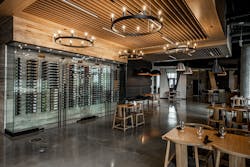Saskatchewan resort uses SSL to define spaces and soften auditory environment
Eureka Lighting (an Acuity brand) has released details of a solid-state lighting (SSL) project in a resort built by the Whitecap Dakota First Nation tribal band near Saskatoon, Saskatchewan, Canada. The Dakota Dunes Resort, located alongside a golf course and a casino, is a 155-room hotel and conference center with architectural elements conceived to pay tribute to its Indigenous heritage. The restaurant and bar space are set in earth themes with high ceilings, and the LED-based lighting scheme was designed to virtually segment the space and in a way that ultimately yielded a pleasant aural environment.
The Dakota Dunes Resort was the work of aodbt architecture + interior design, in collaboration with Lemaymichaud Architecture Design, working with the leadership of the Whitecap band to showcase Indigenous themes and provide a unique cultural experience for guests. Eureka’s agent Titan Electrical Group assisted in the lighting design. The overall resort design includes specific spaces that evoke fire, water, earth, and air.
The restaurant and bar space presented some unique lighting challenges. While the space is not overly large from a square footage perspective, the ceilings are very high. Moreover, the motif for the space was an earth theme and hard surfaces are omnipresent. In the restaurant area, circular, wagon-wheel-size Alver pendants with exposed filament lamps around the perimeter provide direct and indirect lighting (shown above). The lamps radiate upward into wooden acoustic bulkheads.
In the adjacent bar space there are no bulkheads, leaving a higher ceiling, and the designers filled the volumetric space using Mute luminaires mounted at varying heights. The fixtures used are in neutral colors with textures that suggest the earth motif. Furthermore, the Mute design is intended to soften the audial environment.
“Mute’s acoustics properties were an unexpected bonus for us,” said Nicole Tiessen, principal at aodbt and lead interior designer for the hotel. “The luminaires help to control the ambient noise generated from the high ceilings and cement floors but also creates a visual that is soft, layered, and textural.”
It’s also worth noting that sound control is one element that is considered in judging healthy work spaces. While a hotel restaurant and bar area may not be considered like an office space, all lighting for health elements are still important. For more on that concept, review our feature article on the WELL Building Standard from a few years back. We also posted an article on office-space lighting design with hard surfaces earlier this year that emphasized acoustic control.
The resort includes an exhibit corridor that doubles as the primary pathway between the lobby and conference spaces and also to display Indigenous artifacts. The designers intended water as the theme of the corridor that is lined on one slide by floor-to-ceiling windows. Minimalist Celeste luminaires — one of this year’s Sapphire Awards winners — are suspended above the exhibits and light flows over the pendant luminaire surfaces much like a waterfall (shown nearby).
“We selected Celeste because of the organic shape of the glass on the fixture and the ability to stagger multi-stack fixtures; this blended seamlessly with the element of water in this corridor,” said Tiessen. “And we staggered single and double luminaires along the corridor to create the illusion of rain coming down.”
Meanwhile, Focus luminaires blend into the ceiling of the corridor against a black surface. The luminaires are used to highlight features along the hallway and wash walls, delivering indirect ambient light.
The lighting design extends into guest rooms where the air theme is played out. Natural light, custom wallpaper bearing a tribal image, and patterning in the carpet are key. And the SSL elements are discreet Scout pendants that illuminate room surfaces.
“Our team was honored to be a part of such an important project for Whitecap Dakota First Nation and to have created something special for the community,” Tiessen said. “We are thrilled with how the lighting complements the architecture and supports the Indigenous themes throughout. Each fixture in place adds a lot of interest and depth to our design concept.”
LEDs Magazine chief editor MAURY WRIGHT is an electronics engineer turned technology journalist, who has focused specifically on the LED & Lighting industry for the past decade.
For up-to-the-minute LED and SSL updates, why not follow us on Twitter? You’ll find curated content and commentary, as well as information on industry events, webcasts, and surveys on our LinkedIn Company Page and our Facebook page.

Maury Wright | Editor in Chief
Maury Wright is an electronics engineer turned technology journalist, who has focused specifically on the LED & Lighting industry for the past decade. Wright first wrote for LEDs Magazine as a contractor in 2010, and took over as Editor-in-Chief in 2012. He has broad experience in technology areas ranging from microprocessors to digital media to wireless networks that he gained over 30 years in the trade press. Wright has experience running global editorial operations, such as during his tenure as worldwide editorial director of EDN Magazine, and has been instrumental in launching publication websites going back to the earliest days of the Internet. Wright has won numerous industry awards, including multiple ASBPE national awards for B2B journalism excellence, and has received finalist recognition for LEDs Magazine in the FOLIO Eddie Awards. He received a BS in electrical engineering from Auburn University.






